Shami (Banni) tree in Hinduism information, importance, significance, facts, etc. | Is it good to plant Shami tree at home? | Which God resides in Shami tree? | Why Shami is offered to Lord Shiva? | What is the importance of Shami tree in astrology?
Namaste friends, how are you doing today? Welcome to #BhagavanBhakthi website / blog.
Bhagavan Lord Sri Krishna (Vishnu) (Rama) (Trivikrama) and Goddess Sri Lakshmi blessings to you and your family!
In this website / blog, you will always learn about #Hinduism #Sanskrit language.
Also subscribe to my YouTube channel from this link #BhagavanBhakthi to view videos about #Hinduism #Sanskrit language.
Just before going to “Shami (Banni) tree in Hinduism information, importance, significance, facts, etc. | Is it good to plant Shami tree at home? | Which God resides in Shami tree? | Why Shami is offered to Lord Shiva? | What is the importance of Shami tree in astrology?“, let us know a brief, basic and very important information.

Shami or Shamee is a Sanskrit word, also known as Banni in Kannada, Jammi in Telugu, Vanni in Tamil and its botanical name is Prosopis Specigera. Other names: Chhonkra (Uttar Pradesh), Jand (Punjabi), Kandi (Sindh), Sumri (Gujarati), etc.
Shami (Shamee) tree is green throughout the year. The leaves of the shami tree resemble those of the tamarind tree. Shami tree is given great importance in Hinduism, it is worshiped as a sacred and divine tree.
Herbs/stems of Shami tree are used while doing homa. Worshiping the Shami tree is considered an effective remedy for the malefic effects of Shani dosha. It is also used in Ayurveda to cure respiratory problems.
On the day of Vijayadashami, in the evening, people visit the Shami tree in their vicinity with their family and friends and exchange its leaves as a gesture of goodwill.
This ritual is known as ‘Seemollanghana’ (सीमोलन्घन) or crossing the area where they live. We find this celebration of Seemollanghana in the states of Andhra Pradesh, Karnataka and Maharashtra.
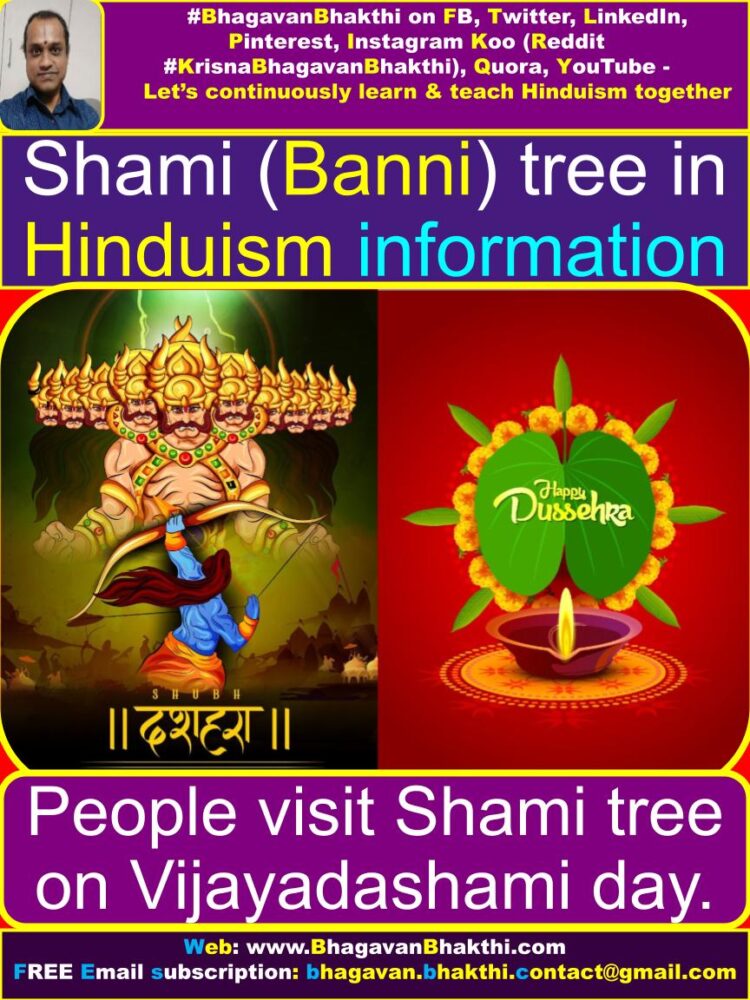
Shami Patram / Leaves (Prosopis Specigera) – is used for respiratory problems. This tree has acquired great importance as the five Pandavas kept their weapons on this tree during their Agyatvas (incognito exile).
This Shami tree is worshiped as a remedy and on the day of Vijaya Dashami we find people doing pradakshina (circumambulation) around this tree.
Pradakshina or circumambulation around the Ashwath (peepal) tree and the Shami tree is recommended to avoid the inauspicious view of Lord Shani.
Why Shami is offered to Lord Shiva? : This is because, Lord Sri Rama loves Shami tree and since Lord Shiva is a great devotee of Lord Sri Rama, Shami leaves are offered to Lord Shiva.

Uses of chanting mantras under the Shami vriksha / tree are as given below:
1. If we dig well near this Shami vriksha / tree, then definitely we can get sweet water in that well.
2. If someone meditates a mantra for an hour or even half an hour under Shami vriksha / tree, long timed diseases will be cured.
3. Keeping leaves of Shami vriksha / tree in house will give relief from Vaastu dosha / problems.
4. Heart problems can be cured by inhaling air of this vriksha / tree of Shami.
5. One who is childless, they are advised to make pradakshina / circumambulation in the clockwise direction under this Shami / vriksha tree in early morning to begot child.
6. Offering Pooja / worshipping Shami vriksha / tree for 21 days will give relief from any Black magic.
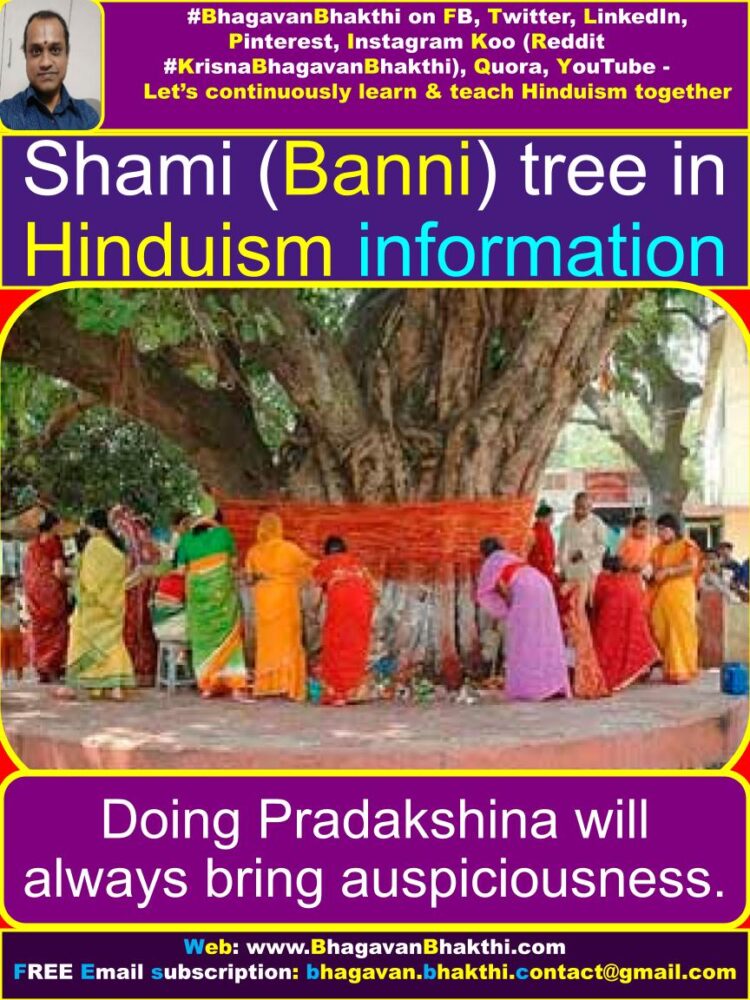
7. Doing pradakshina / circumambulation around this Shami vruksha / tree for 48 days (48 days in total becomes one whole mandala / full cycle) is recommended for unmarried people to get marriage arranged.
8. Tonic made up of wood of this Shami vruksha / tree will cure diseases like asthama, bronchitis, dysentery, loco derma, piles etc.
9. Shami is helpful for pregnant woman to prevent any miscarriage.
Importance of Shami tree for Mysuru King of Karnataka
Even today the Mysuru Wadeyar do the pooja of Shami tree / Banni tree during the Navatrati time.
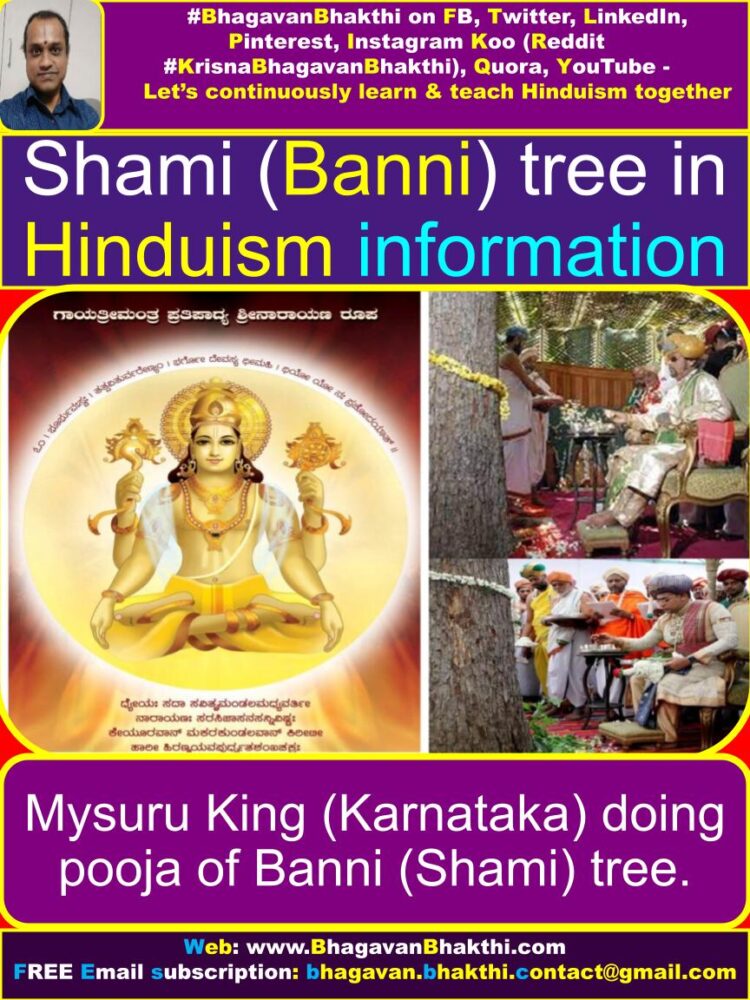
Why should we worship Shami vriksha / tree : To know this answer we need to know story that comes in the Great Epic of Mahabharata.
We all know that, Great Pancha Pandavas lost to the Kauravas in the game of dice and thus Pancha Pandavas along with Draupadi Devi were told to leave both Hastinapura and Indraprastha.
And also Pandavas were told to live in a forest for 12 years (vanavasa / forest exile) and then remain incognito (Agyatvas) for one year (that is, in the 13th year of exile).
Thus Pancha Pandavas along with Draupadi Devi after completing 12 years of exile, they decided to remain incognito in the kingdom of King Virata, by disguising themselves for the next one whole year.
Before approaching the King Virata, Pancha Pandavas and Draupadi Devi wrapped up their divine astras and shastras (weapons) in a huge cloth and kept it on a high branch of a Shami tree near the cremation ground outside the city of the King Virata.

Mahabharata says that, it was on the day of ‘Vijaya Dashami’ (the day after the Navaratri) that they successfully completed their one whole year of incognito life.
Also, we all know that the mid Pandava, that is, Arjuna collected the astras and shastras (weapons) from the Shami tree and defeated the Kauravas who attempted to steal the cattles of the King Virata.
Thus from that day, Shami tree and astras and shastras (weapons) have been worshiped on the ninth day of Navaratri (that is, on Ayudha Pooja day – a day before ‘Vijaya Dashami’) symbolising this particular incident in the Great Epic of Mahabharata.
Also from that day all the Pancha Pandavas and Draupadi Devi started worshipping the Shami vriksha / tree as their ‘kuladevata’ / ‘Family God’.
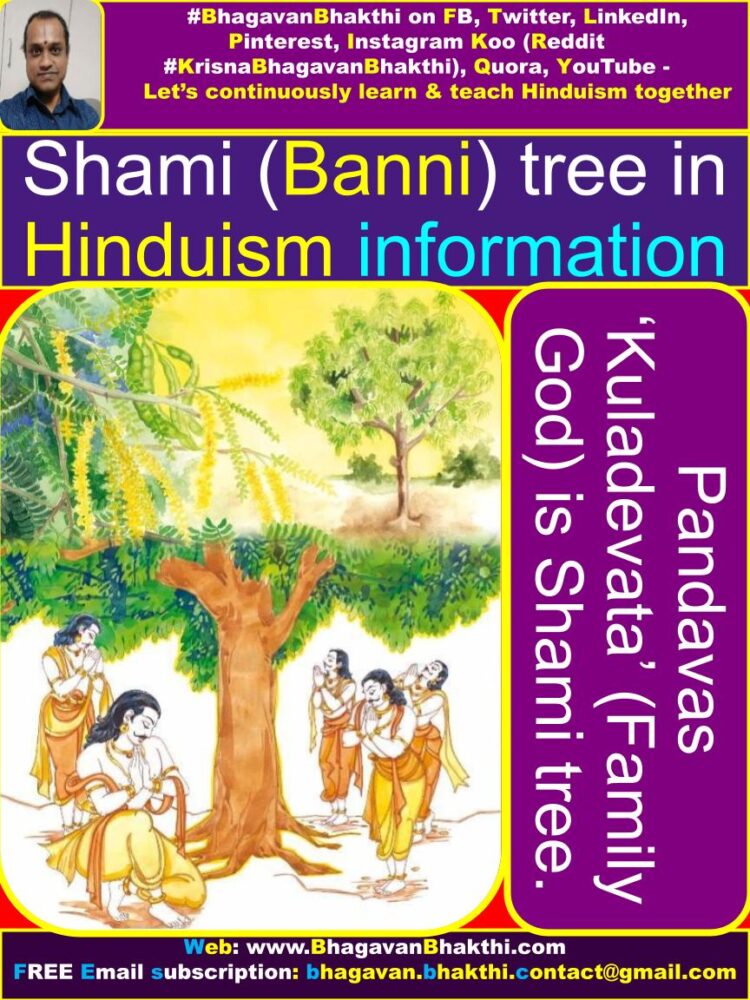
Relationship of Shami vriksha / tree and Lord Sri Srinivasa / Balaji is as given below:
When Lord Sri Vishnu took avatar as Lord Sri Srinivasa / Lord Sri Venkatesha / Lord Sri Venkateswara / Lord Sri Balaji following story takes place:
This story starts when the ‘vivaha mahotsava’ / marriage ceremony of Lord Sri Srinivasa with Goddess Sri Padmavati Devi was going on. At that time the Great Maharshi Vasishtha was the poojari / main priest of that mahotsava / ceremony.
Maharshi Vashistha asked Lord Sri Srinivasa (Balaji) as to who is your Kuladevata is? as he has to do the ‘sthapana’ (install) of Kuladevata (Family God) during that time.
For this Lord Sri Srinivasa (Balaji) told that his kuladevata for him as well as for Pandavas is “Shami”.
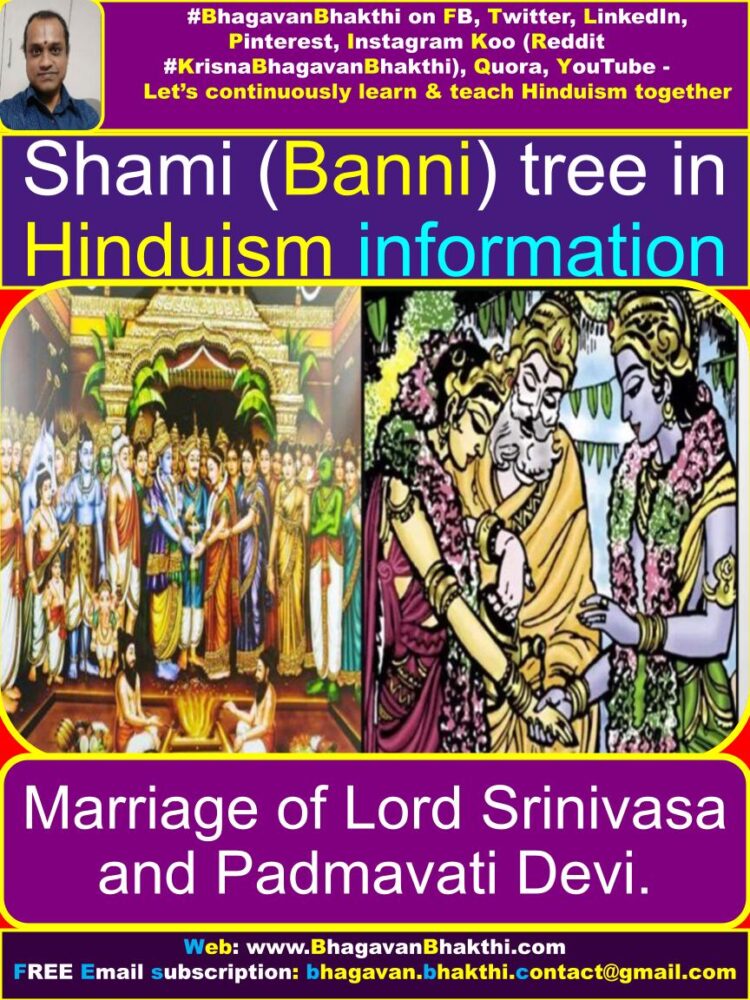
After this, Agastya Rishi gave the direction that the Shami Vriksha (Tree) is near ‘Kumara Dhara Tirtha’ and asked Lord Sri Srinivasa to go and bring a branch of the tree.
For this Lord Sri Srinivasa (Balaji) went to the “Shami” tree and did the namaskaram and prayed like this:
[“Shami” was the kuladevata (Family God) for Pandavas and even Lord Sri Srinivasa (Balaji) also told that it is his kuladevata is also “Shami”.]
शमि शमयतॆ पापं शमी शत्रुविनाशिनि । आर्जुनस्य धनुर्धारि रामस्य प्रियवादिनि ।
ಶಮಿ ಶಮಯತೆ ಪಾಪಂ ಶಮೀ ಶತ್ರುವಿನಾಶಿನಿ | ಆರ್ಜುನಸ್ಯ ಧನುರ್ಧಾರಿ ರಾಮಸ್ಯ ಪ್ರಿಯವಾದಿನಿ |
śhami śhamayate pāpaṁ śhamī śhatruvināśhini | ārjunasya dhanurdhāri rāmasya priyavādini |
Meaning of this shloka is as given below : “Shami Tree destroys our sins, it also destroys our enemies. It was holding the Dhanush (bow) of Arjuna for one full year and it is Lord Sri Rama’s most favorite tree.”
By saying so, he (Lord Sri Srinivasa) did the pooja of the Shami Vriksha / tree and cut one branch of Shami vriksha and keeping it over his head, he (Lord Bhagavan Sri Srinivasa) brought it accompanied by ‘mangala vaadyas’ (auspicious musical instruments).
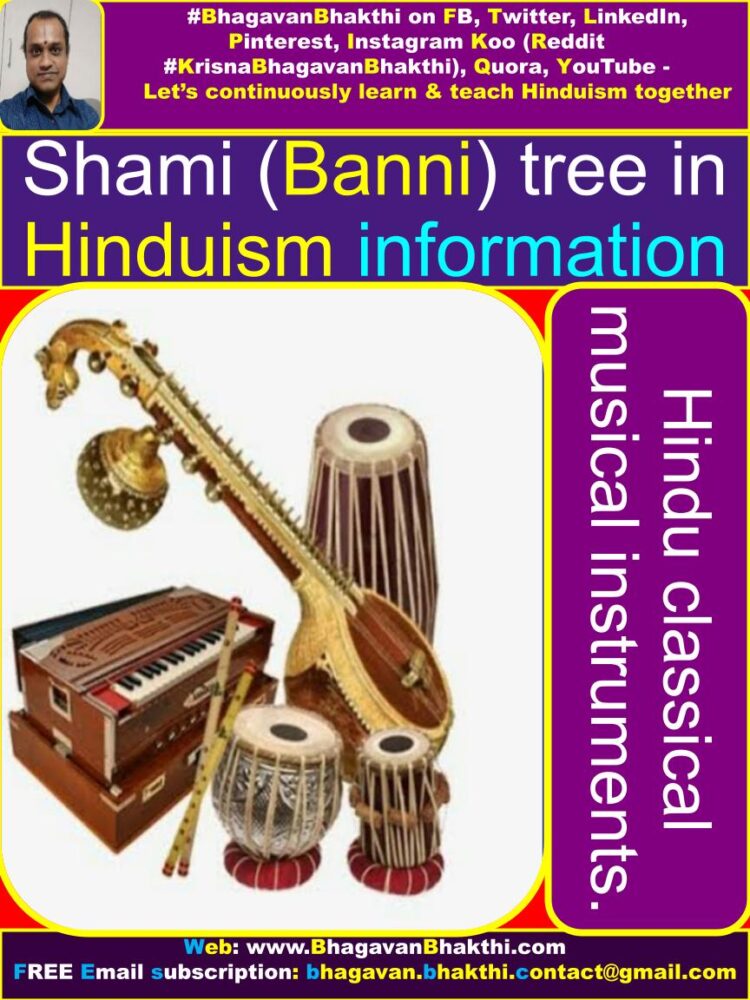
Maharshi Vashishtha did the sthapana (installation) of Shami branch in the place of which belongs to Lord Sri Srinivasa (that is, near Lord Sri Varaha Svami’s sannidhana).
Lord Sri Srinivasa (Balaji) requested Lord Sri Varaha Svami to come to his vivaha mahotsava / marriage ceremony along with Goddess Sri Dharani Devi (Goddess Sri BhuDevi – Lord Sri Varaha’s consort) to the Akasha Raja’s palace.
(We should always remember that both Lord Sri Srinivasa / Balaji and Lord Sri Varaha Svami are same and are the avatars of Lord Sri Vishnu and there is no bedha / difference in between the two – this act of Lord Sri Srinivasa is for lokareetya / to teach lessons to common man.)
Thus, Lord Sri Varaha Svami replied that he is busy with the crop season and as such he is sending Sri Bakula Devi (Lord Sri Srinivasa’s mother) as his representative.
Lord Sri Srinivasa (Balaji) did the pratista (appreciation) of Shami vriksha (tree) in the sannidhi (presence) of Lord Sri Varaha Svami.
Lord Bhagavan Sri Srinivasa (Balaji) called Lord Sri Brahma Deva and instructed him to send all the people to Narayanapura (Lord Sri Srinivasa mother Bakula Devi’s place).

Thus, Lord Sri Brahma Deva replied that after doing the ‘Kuladevata pratistaana’ (installation of Family God) and ‘Naandi samaaraadhana’, one must arrange for ‘Brahmana samaaraadhana’ and get their blessings.
As such, without doing bhojana (food), when everybody is hungry it is improper to move from here.
For this Lord Sri Srinivasa (Balaji) replied like this: “I don’t have any money with me and when I came from Vaikuntha, I have not brought anything with me.”
“I have already spent nearly 10,000 years here with extreme difficulties in this place. Thus, it is not possible for me to arrange for bhojana (food) for all now”.
After these words from Lord Sri Srinivasa (Balaji), Lord Sri Brahma Deva kept silent.
Whereas Lord Sri Rudra Deva (Shiva) said like this: “If someone is having money, then at least one must borrow money and do should do all the required arrangements”.
After all these discussions, ‘Runa / Loan agreement’ was signed by Lord Sri Srinivasa (Balaji) himself on Vilambi naama samvatsara (year), Vasanta Rutu (season), Vaishaka maasa (month), Shukla saptami (day).
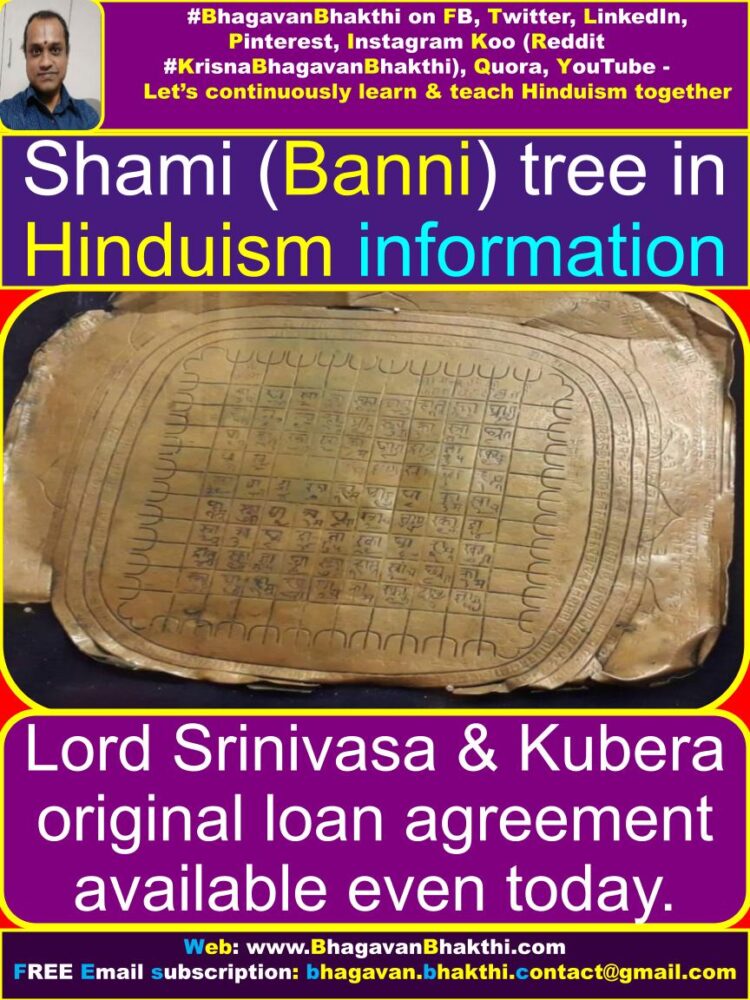
The loan amount was ’14 laksha Raama Tankee varahas’ (14 Lakhs). This has to be returned with interest + principal interest by Lord Sri Srinivasa to Lord Kubera.
This total amount has to be repaid (with interest and principal interest) by Lord Bhagavan Sri Srinivasa (Balaji) to Kubera before the end Kaliyuga (that is, before 100 years of the end of Kali Yuga).
Witnessees were: Lord Sri Brahma Deva, Lord Sri Trinetra Panchamukha Rudra Deva (Shiva), and Shami Vriksha / tree.
Why Shamee (Shami / Banni) leaves are exchanged among people (Brahmins, Kshatriyas and others):
People distribute Shamee (Shami) tree leaves on Dussehra (Dasara) and Vijayadashami day. In this Hindu ritual, the leaves of the Shamee (Shami) tree symbolically represent gold or (स्वर्ण) svarna or sona.
People offer Shami tree leaves to friends, relatives and neighbors to wish each other Dussehra. There is an interesting story as to why Shami tree leaves are offered on Dussehra (Dasara) day.
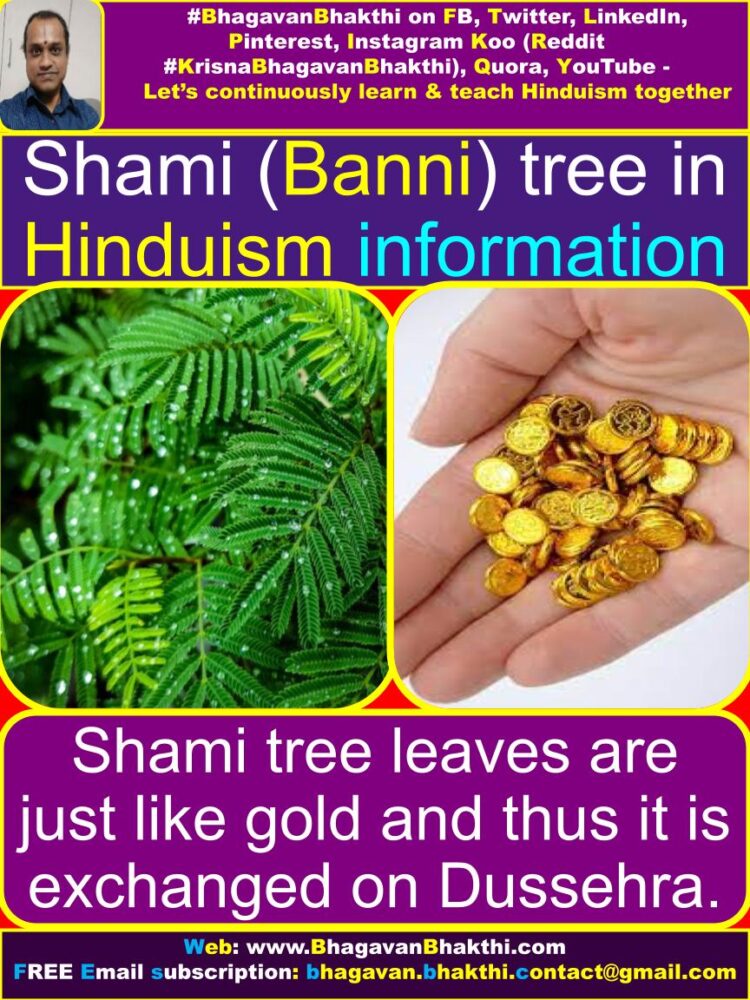
There is a story about Guru Dakshina and Shami Tree as given below:
During the Treta Yuga, a young Brahmin named Kautsa stayed in Ayodhya. He had completed his education from his Guru, and he asked his guru to accept the Guru Dakshina – a gift offered by students to a guru named Varatantu after completing their studies.
Guru Varatantu first said that he did not want any Dakshina. But the young Kautsa insisted that he should take Dakshina. Guru Varatantu asked for 14 crores (140 million) gold coins to teach Kautsa a lesson. One hundred million per subject taught.
The student Kausta went to Lord Sri Rama who was ruling Ayodhya at that time and asked for the gold coins required to pay his Guru Varatantu as ‘Gurudakshina’.
Our beloved Lord Sri Rama promised to help young Kautsa and asked him to wait near the Shami tree (the Shami tree is very dear to Lord Sri Rama).
In three days, Lord Sri Rama, with the help of Lord Kubera, poured gold coins from the leaves of the Shami tree, the treasure of God. The leaves of the trees became gold coins.
The young Kautsa collected gold coins from Lord Sri Rama blessings and gave 140 million gold coins to his Guru Varatantu as ‘Gurudakshina’. The rest of the coins were distributed to the needy by Kautsa.

It happened on the day of Dussehra (Dasara) day. To commemorate this event even today people collect leaves of Shami tree and offer them as gold to their family, relatives, neighbors and all well-wishers.
One story about Shami tree: There used to be a great Rishi called Rishi Jarva and his wife Sumedara. This couple had a very beautiful daughter called Shamika.
When this daughter attains the age of marriage, both Rishi Jarva and Sumedara made marriage with a person called Mandara. This Mandara was the son of Dhaumya Rishi and a student of Kaushika Maharshi.
Once this the newly married couple Mandara and Shamika went for a walk in a nearby forest (similar to a park).
While walking in the forest (similar to a park) both Mandara and Shamika saw a Rishi called Rishi Bhrusudi with unlimited number of Elephants’ trunks on his face and they both Mandara and Shamika started laughing at him.
Seeing this Rishi Bhrusudi asked the reason for their laughing. But they both Mandara and Shamika instead of saying the reason, they insulted the Rishi by laughing continuously.
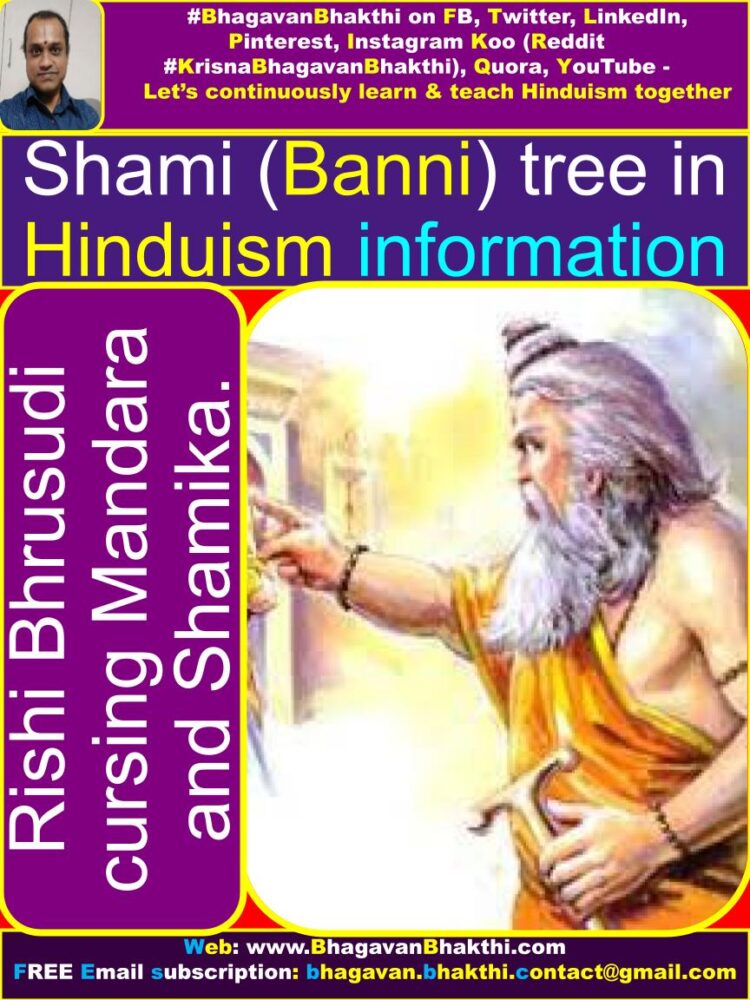
In-turn the Rishi Bhrusudi got anger and cast a curse on both Mandara and Shamika that they will become vrikshas / trees which will be of no use for any living creatures.
After this, the couple Mandara and Shamika realized their fault and started to beg for the mercy of the Rishi Bhrusudi.
Thus, Rishi Bhrusudi told that when you have darshanam (divine view) of Lord Ganesh, then your curse will finish. So, Shamika became Shami tree and Mandara became Mandara Tree.
But on the other side, both Rishi Jarva and Sumedara were waiting for a long time for their daughter Shamika and son-in-law Mandara to return back.
But, after a long time when both Rishi Jarva and Sumedara lost their hope, they went in search of their daughter Shamika and son-in-law Mandara.
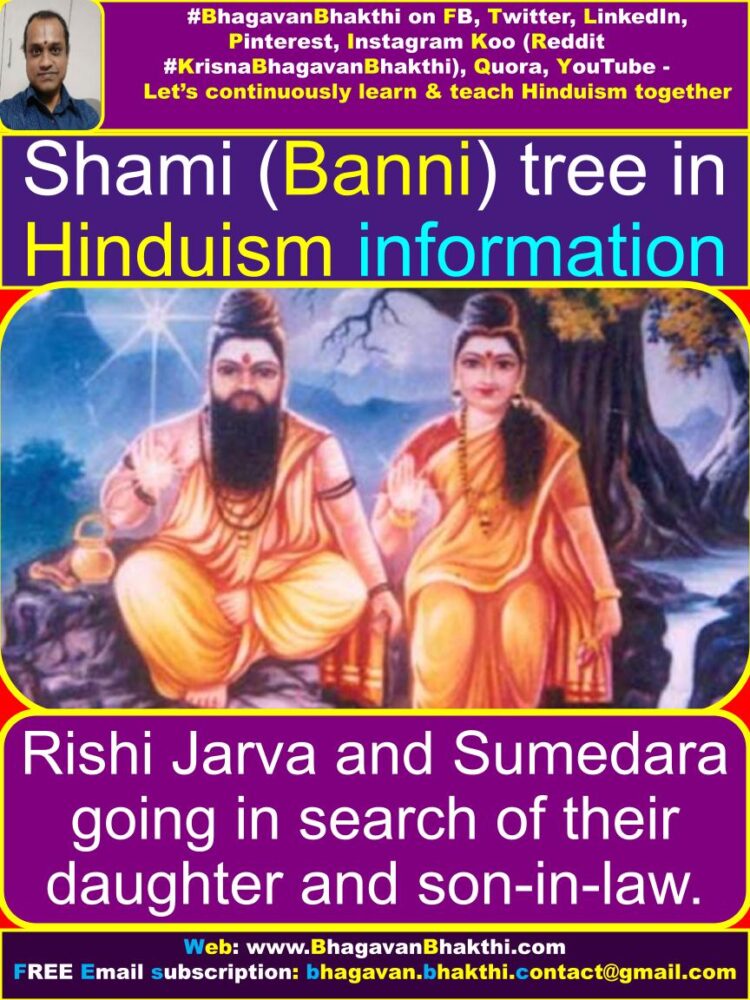
Rishi Jarva and Sumedara saw two new trees which they have not seen in their life. Rishi Jarva and Sumedara came to know about the incident by some Rishis who were present at that moment.
Thus, knowing everything both Rishi Jarva and Sumedara teached the Maha Ganapati mantra which was told to them by great Maharshi Durvasa.
After knowing the Maha Ganapati mantra both Shamika and Mandara both of them started chanting the mantra with great devotion.
Later after a long time, one day Lord Ganesha / Ganapati gave darshan to both Shamika and Mandara and they were freed from their curse.

Continue reading about Hinduism (Sanatana Dharma) :
Lord Sri Srinivasa (Balaji full information)
Ramayana information, facts, significance, importance, etc.
Maharishi information, facts, importance, significance, etc.
Rivers information in Hinduism (Sanatana Dharma)
Hinduism (Sanatana Dharma) information, facts, etc.
Mahabharata information, facts, significance, importance etc.
More information will be added to his post (article) on regular basis. Please visit again to know the updated information after some time.
To watch videos on #Hinduism #Sanskrit language, SUBSCRIBE to my YouTube channel from this below link:
#BhagavanBhakthi YouTube channel
To know more about “Lord Sri Vishnu stories, information, facts, significances, etc.“, please click the below link:
Lord Sri Vishnu stories, information, facts, significances, etc.
Dear friends, if you need any clarifications about this post, kindly let me know, I will definitely try to answer all of them.
Also your one LIKE, one COMMENT, One Share, one SUBSCRIPTION is highly important.
This will help to know the quality of this content and also it will be helpful to know if any improvements is required for the content.
If you feel this content is useful to you and has helped you to improve your knowledge, kindly share this with your well-wishers.
Because “SHARING MEANS CARING”.
For receive FREE EMAIL SUBSCRIPTION about #BhagavanBhakthi, you can send an email to [email protected] from your email ID.
NAMASTE!
SRI GURUBHYO NAMAHA
OM NAMO NARAYANAYA
Sri Krishnaarpanamastu
Share in Social Media
Banni tree planted any place of direction any time anywhere
Namaste Prakash,
Banni (Shami) tree is highly auspicious.
Shubhamastu!
Banni mara wrong vastu direction harm people
Dear Prakash Ji,
Anything wrong will definitely harm the individual as per his/her Karmas.
Shubhamastu!